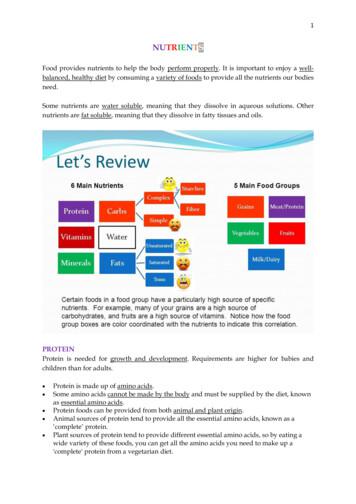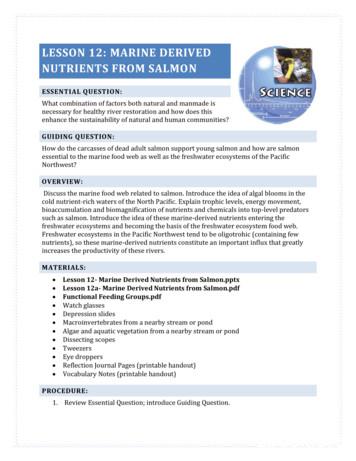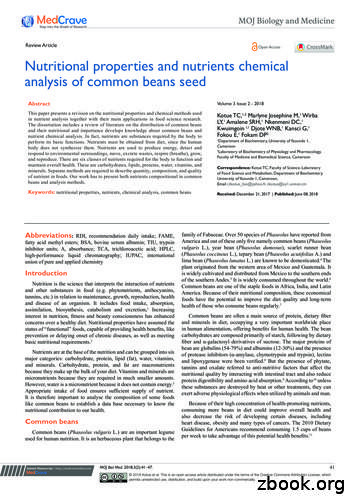NUTRIENTS - Sc-s.si
1NUTRIENTSFood provides nutrients to help the body perform properly. It is important to enjoy a wellbalanced, healthy diet by consuming a variety of foods to provide all the nutrients our bodiesneed.Some nutrients are water soluble, meaning that they dissolve in aqueous solutions. Othernutrients are fat soluble, meaning that they dissolve in fatty tissues and oils.PROTEINProtein is needed for growth and development. Requirements are higher for babies andchildren than for adults. Protein is made up of amino acids.Some amino acids cannot be made by the body and must be supplied by the diet, knownas essential amino acids.Protein foods can be provided from both animal and plant origin.Animal sources of protein tend to provide all the essential amino acids, known as a‘complete’ protein.Plant sources of protein tend to provide different essential amino acids, so by eating awide variety of these foods, you can get all the amino acids you need to make up a'complete' protein from a vegetarian diet.
2CARBOHYDRATES (CARBS)Most of the energy (calories) we need should come from carbohydrates. Carbs, along with fatand protein, provide energy so we can perform our daily activities. Carbs are split into twotypes:FIBREDietary fibre is a term that is used for plant-based carbohydrates that, unlike othercarbohydrates (such as sugars and starch), are not digested in the small intestine, so fibrereaches the large intestine (helps with the digestion).There are two main groups of fibre: soluble and insoluble. Soluble fibre reduces cholesterol inthe blood and controls blood sugar levels. Insoluble fibre helps keep your digestive tract ingood working order. They work in different ways so it is important to include both types inyour diet. What is important to remember is that fibre-rich foods typically contain both typesof fibre.VITAMINSVitamins are essential for our health (the name comes from “vital”). Many different vitaminsare present in food. However, they are required in small amounts to maintain good health.Most of us should meet our vitamin requirements by eating a healthy, well balanced diet.Certain groups, however, for example the sick, elderly, post-menopausal women, pregnantwomen or individuals following restrictive diets, may need to take an additional vitaminsupplement.Hypervitaminosis is a condition of abnormally high storage levels of vitamins, which can leadto toxic symptoms. Toxic levels of vitamins are generally a result of high supplement intakeor a large intake of highly fortified foods and not from natural food.
3Vitamins have diverse functions in the body: Hormone-like functions as regulators of mineral metabolism (vitamin D) Regulators of cell and tissue growth and development (vitamin A) Antioxidants (vitamin E, C) Help to enzymes (B complex)FATIt provides energy, absorbs certain nutrients and maintains your core body temperature. Youneed to consume fat every day to support these functions, but some types of fat are better foryou than others. While carbohydrates are the main source of energy in your body, your systemturns to fat as a backup energy source when carbohydrates are not available.Fatty acids are the building blocks of fat and there are three different types: saturated fattyacids, monounsaturated fatty acids and polyunsaturated fatty acids.While monounsaturated and polyunsaturated fats can lower blood cholesterol and helpreduce the risk of heart disease, saturated fats can raise blood cholesterol and increase the riskof heart disease.There is a special sub group of polyunsaturated fatty acids known as Essential Fatty Acids(EFAs). They are called 'essential' as they are not easily manufactured by the body and mustbe provided by food. They are split into two groups: Omega 3 and Omega 6.Trans fatty acids are a form of fat that the body does not actually need and only have adverseeffects.MINERALSAlong with vitamins, minerals are vital nutrients found in food, which help the body toconvert food into energy, control body fluids and build strong bones and teeth.Minerals are found in a wide variety of foods including fruit, vegetables, cereals, milk anddairy products, meat and fish. There are two types of minerals your body needs to stayhealthy: major and trace minerals. As their names suggest, these kinds of minerals are dividedby need. Your body needs large amounts of major minerals and only very small amounts oftrace minerals for normal function. CalciumMagnesiumPotassiumSodiumPhosphorousIron (trace mineral)
4WATER
5EXERCISES1. Answer the questions.1. How can we provide all the nutrients our body needs?2. Explain the term essential amino acids.3. What is the difference between simple and complex carbs?4. Explain the terms soluble and insoluble fibre.5. List 3 different ways of vitamin intake., ,6. Vitamins are needed in small amounts – what problems may occur?7. Explain the term essential fatty acids.8. Explain the terms major and trace minerals and name them.9. Explain the importance of water in human body.
62. Complete the rbohydratesfatswaterViri (pridobljeno t-on-nutrients?next slideshow gle.si/search?q Nutrients&tbm isch&tbs rimg:CWE8jFAParvpIjhVrsPAAbIrGug wGMRgo82J7neh1IqEgnLnPdiyb7FfBENAswT4u 1w6CoSCcaDIRznpRJYEYAEHOuOFDHgKhIJAfVmMAZ OdsWeQEQsifFf 13k75&tbo u&sa X&ved 2ahUKEwiQh5LXs7nZAhWSr6QKHVmJD0kQ9C96BAgAEBw&biw 1280&bih 918&dpr 1#imgrc soqQk2usN1J on-facts/know your on/water-fonctions-in-human-body
NUTRIENTS Food provides nutrients to help the body perform properly. It is important to enjoy a well-balanced, healthy diet by consuming a variety of foods to provide all the nutrients our bodies need. Some nutrients are water soluble, meaning that they dissolve in aqueous solutions. Other
Lesson 2: Nutrients We Need 29 2. Nutrients We Need. OBJECTIVES . To emphasize the similarities between humans and plants in the need for nutrients To learn about the six classes of nutrients and why we need all six of them To learn how to identify good food sources of selected nutrients To learn how plants provide us with nutrients
Marine-derived nutrients (MDN)-Nutrients acquired by an anadromous fish and deposited in a freshwater or terrestrial ecosystem when that fish dies. Oligotrophic- Containing few nutrients and therefore unable to support much life . Eutrophic- An ecosystem containing high levels of nutrients and therefore supporting
Manure contains both macro- and micro-nutrients needed for crop production in organic and inorganic forms. Inorganic nutrients are readily available to the growing crop, while the organic nutrients become available gradually over time. A crop responds to inorganic nutrients in soil, whether they originate from manure or commercial fertilizer.
Module - Classes of Nutrients Learning Objectives Beginner List the five classes of nutrients. Identify common sources for each nutrient. Intermediate Explain functions of common nutrients in horses. Discuss the difference between micro- and macro-nutrients. Seniors Discuss the concept of "most limiting nutrient."
3 Fertilizers & Nutrients Source: All plants need nutrients to grow and reproduce. Three major nutrients are nitrogen, phosphorus, and potassium, and stormwater can collect these nutrients from fertilizers,
Nutrients are essential for crop production. All plants require nutrients to grow and a significant portion of these nutrients are removed and exported when a crop is harvested. Sustainable crop production requires the nutrients that are removed to be replaced with synthetic fertilizers, manures, municipal wastes or, in a few cases, the atmosphere.
Nutrients must be obtained from diet, since the human body does not synthesize them. Nutrients are used to produce energy, detect and respond to environmental surroundings, move, excrete wastes, respire (breathe), grow, and reproduce. There are six classes of nutrients required for the body to function and
Soldier’s level of functioning as of the last developmental counseling session IAW AR 380-5, paragraph 5-5; and AR 25-2, paragraph 4-5. 2. First line leaders should: a. Conduct counseling sessions addressing the domains identified on the USA SLRRT with all Soldiers for whom they are responsible IAW paragraph F: Policies and























